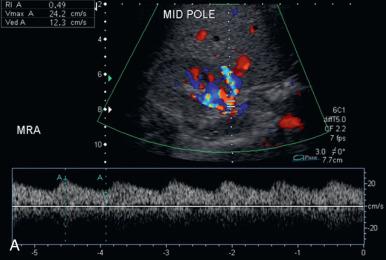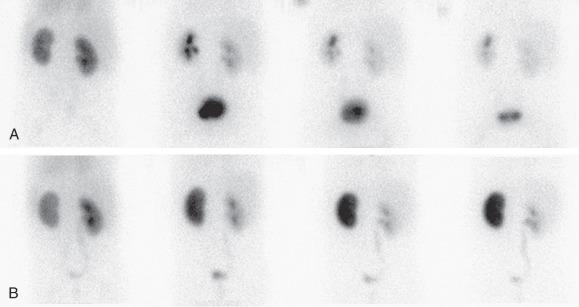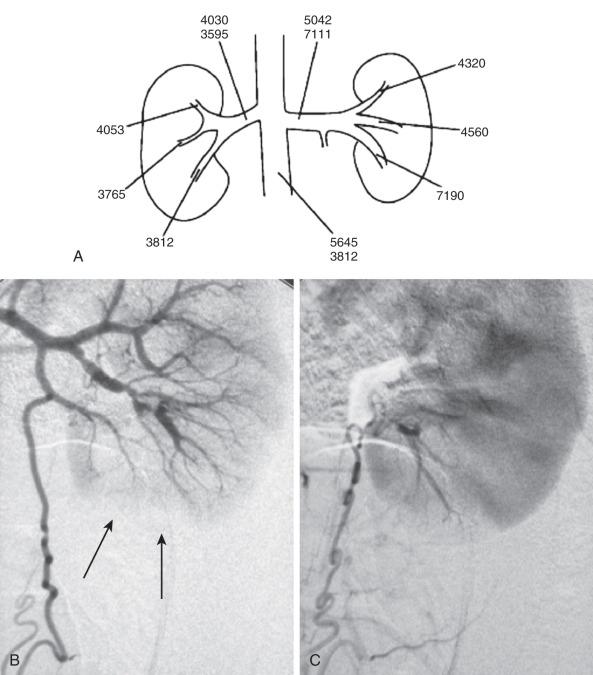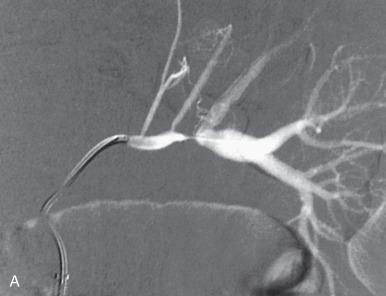Physical Address
304 North Cardinal St.
Dorchester Center, MA 02124
Approximately 5% to 10% of children and adolescents with severe hypertension have an underlying renal vascular lesion. In children younger than 5 years, up to 80% of clinically significant hypertension is due to renovascular disease. There are myriad developmental and acquired causes of renovascular hypertension ( Box 116.1 ). A complication related to umbilical artery catheterization is the most common cause of renovascular hypertension in neonates. In older children, renal arterial dysplasia is the most common cause.
Inflammatory Disease
Vasculitis (e.g., Takayasu arteritis)
Moyamoya disease
Irradiation
Williams syndrome
Neurofibromatosis type 1
Feuerstein-Mims syndrome (Schimmelpenning syndrome)
Degos disease
Marfan syndrome
Hyperlipidemias
Renal arteriovenous malformation
Renal artery aneurysm
Renal artery hypoplasia
Umbilical artery catheterization
Neonate of diabetic mother
Sepsis/dehydration
Rejection
Arterial narrowing
Congenital rubella
Compression by mass
Congenital fibrous band
Posttraumatic cause
Retroperitoneal fibrosis
Renal size asymmetry on sonography is an important sign of possible renovascular hypertension, as the affected kidney often is small. The examination should include assessment of the renal vessels and aorta with gray-scale and color Doppler images, as well as spectral Doppler of the renal arteries and suprarenal aorta. In children, the most specific diagnostic sonographic findings for renovascular hypertension are visualization of a stenosis on color Doppler images (with turbulent flow and aliasing) and a tardus-parvus spectral Doppler pattern distal to the stenosis (slow systolic acceleration and diminished peak systolic velocity, often associated with a decreased resistive index) ( Fig. 116.1 ). Objective criteria for poststenotic blood flow alterations include acceleration index <300 cm/sec and acceleration time >70 msec; there is commonly flattening of the systolic peak. Measurements at the stenotic segment show a renal artery-to-aorta peak systolic velocity ratio >3.5 and a peak systolic velocity of >200 cm/s.

The most useful scintigraphic technique for detection of renovascular hypertension involves the evaluation of renal function without and with the use of an angiotensin-converting enzyme inhibitor, usually captopril or enalaprilat. Tc-99m mercaptoacetyltriglycine (MAG3) is the optimal imaging agent for this study. In the presence of renovascular disease, imaging in conjunction with angiotensin-converting enzyme inhibitor therapy typically shows diminished perfusion, diminished initial uptake, and poor parenchyma clearance of the affected kidney. Comparative imaging in the absence of the medication shows improved function ( Fig. 116.2 ). However, children often have segmental arterial or smaller disease, making perfusion changes difficult to detect, and thus scintigraphy has a limited role in children.

Computed tomographic angiography (CTA) and magnetic resonance angiography (MRA) are noninvasive techniques for visualization of renal vascular anatomy. Upon administration of contrast material, global and regional alterations in kidney perfusion and function also can be assessed. Both of these modalities have limited sensitivity for detecting intrarenal stenoses.
Transcatheter angiography remains the gold standard technique for detection and characterization of renal arterial stenosis and should be considered when noninvasive tests are nondiagnostic, or when there is a clinical suspicion of small vessel disease. In general, >50% narrowing of the renal arterial diameter is hemodynamically significant. The presence of enlarged collateral pathways is an additional indicator of significant renal artery stenosis. Transcatheter renal vein renin sampling is useful in selected cases of suspected renal hypertension ( e-Fig. 116.3 ).

Renal artery dysplasia (commonly referred to as fibromuscular dysplasia , or FMD) is the most common cause of renal artery stenosis in children ( Fig. 116.4 ). Hypertension is the typical presenting feature; other potential clinical findings include headaches and an abdominal bruit. Subcategorization of FMD is based on the layer of the arterial wall that is involved.

Primary intimal fibroplasia is characterized by circumferential accumulation of collagen subintimally and within the internal elastic membrane. This form is the most common cause of renal artery stenosis in children. Imaging shows a smooth, bandlike, tubular, or funnel-shaped stenosis that usually involves the distal two-thirds of the renal artery or a branch vessel.
Perimedial or subadventitial fibrodysplasia involves collagen deposition in the outer border of the media over a variable length of the renal artery. Angiography typically shows severe long-segment beaded narrowing of the renal artery. This disease occurs almost exclusively in girls older than 10 years of age. About 15% of patients have bilateral involvement.
Fibromuscular hyperplasia is an extremely rare vasculopathy. Concentric thickening of the renal arterial wall is due to proliferating smooth muscle and fibrous tissue. Angiographically, this lesion appears as a smooth stenosis of the renal artery or its branches. The appearance often is indistinguishable from that of intimal fibroplasia.
Medial fibroplasia is rare in children. Alternating areas of focal thinning of the internal elastic membrane and focal collagenous thickening of the medial muscular layer are present. Angiographically, there is a “string-of-beads” appearance, typically involving the distal two-thirds of the main renal artery and its branches. Areas of dilation between stenoses are usually greater in caliber than the normal renal artery.
The most common vascular pathology in patients with neurofibromatosis type 1 is stenosis of the aorta or a large branch vessel. Occasionally, an aneurysm occurs. In the kidney, a small-vessel mesodermal dysplasia also can occur. Arterial stenosis in these patients is often long and tapered.
Become a Clinical Tree membership for Full access and enjoy Unlimited articles
If you are a member. Log in here